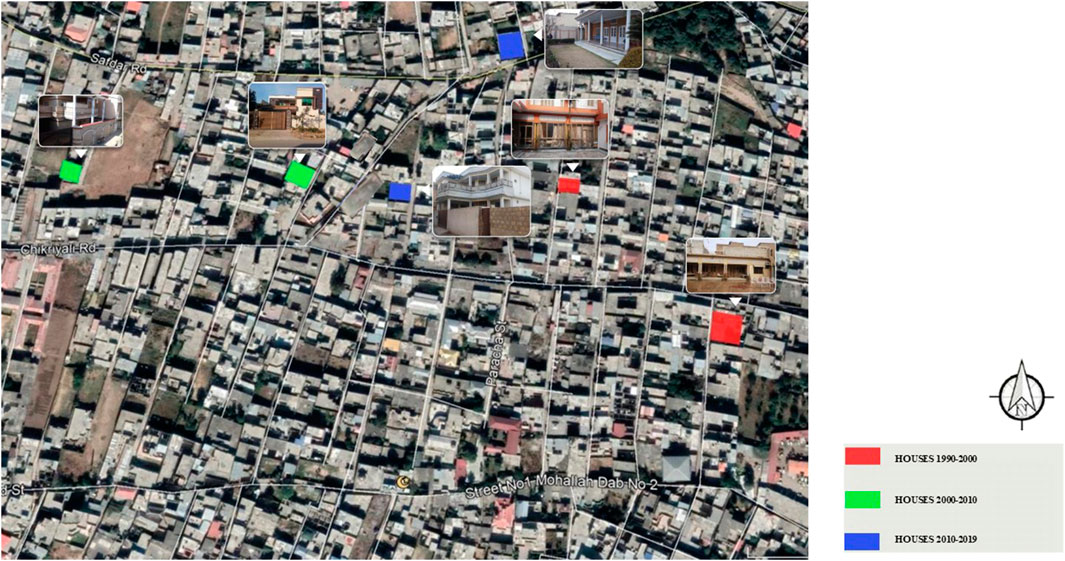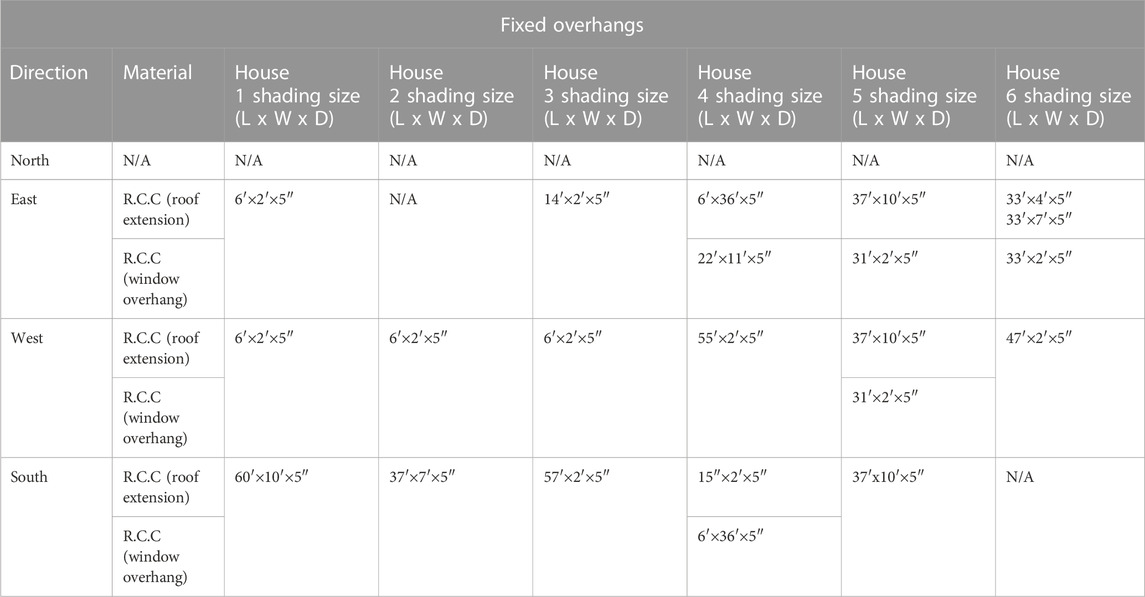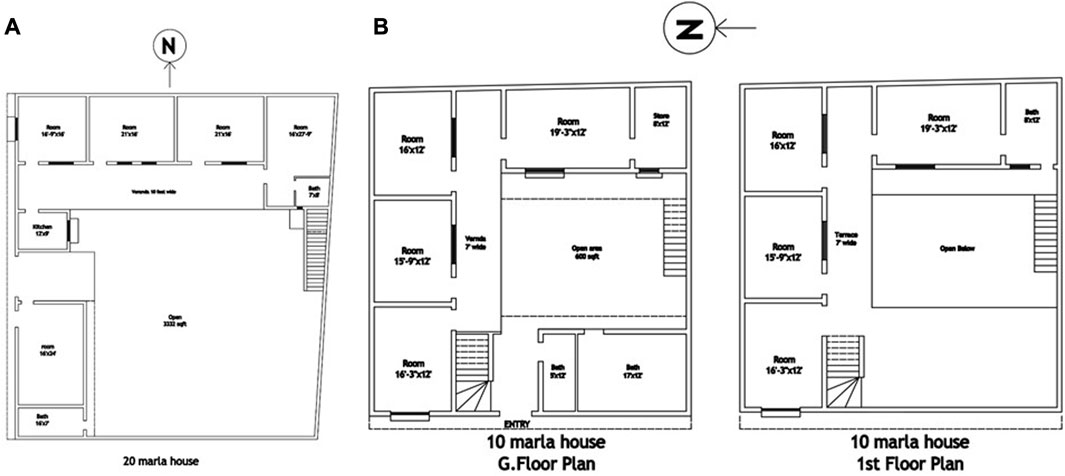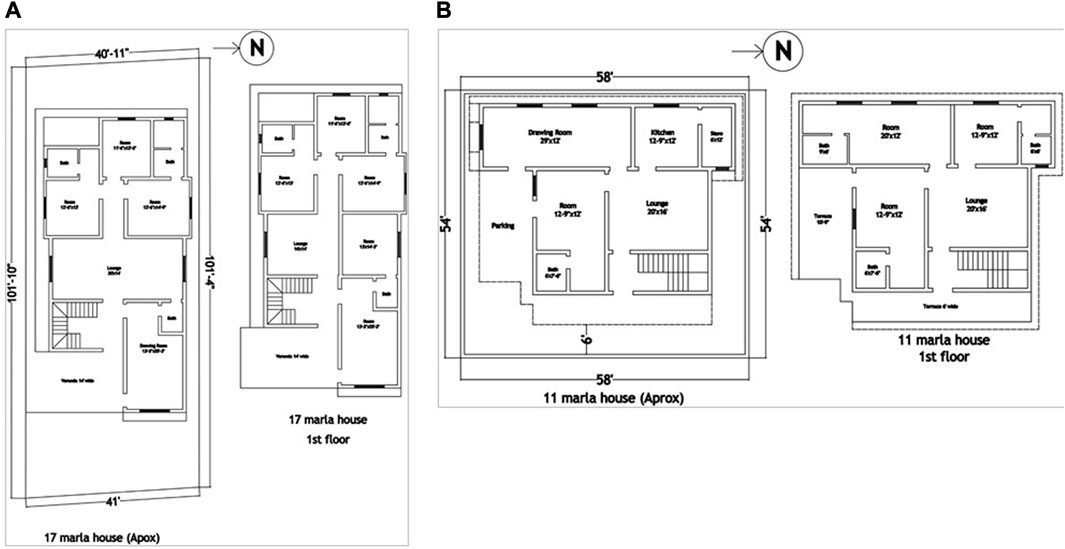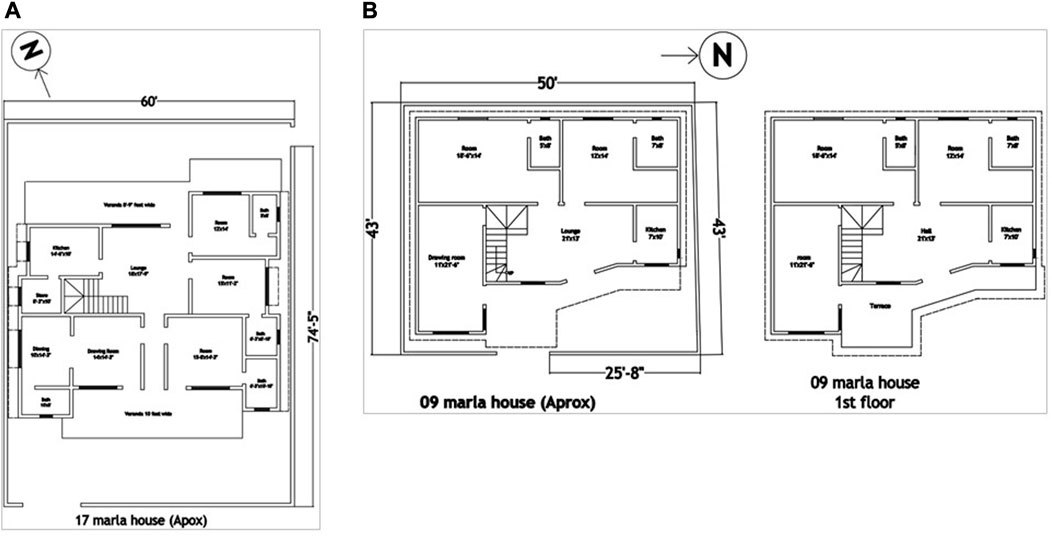Design of external shading devices in Mansehra, Pakistan and their role in climate change
- 1Department of Computer and Geospatial Sciences, University of Gävle, Gävle, Sweden
- 2Department of Architecture and Environmental Design, Sir Syed University of Engineering and Technology, Karachi, Pakistan
- 3Department of Architecture, Hazara University, Mansehra, Pakistan
With the rising global temperatures, developing countries are one of the most adversely affected countries by climate change. Furthermore, changes in lifestyle and unsustainable ways of development have resulted in a shift away from passive strategies in the construction industry, which contribute to excessive energy consumption. This demands immediate action to use passive strategies and one of the most widely used passive strategies is shading devices, which can significantly lower the indoor temperature and give the structure the most efficient energy performance. Shading devices were a dominant identity of traditional architecture in Pakistan; however, it has been evident during the past decade the use of such devices has become obsolete due to modernized solutions. This study aims to examine the performance and effectiveness of shading devices in terms of heat gain and daylight levels in residential areas. A comparative case study methodology has been used. The fixed overhanging shading devices of six residential units in Mansehra City, Khyber Pakhtunkhwa province, Pakistan, have been used. Sun angles are calculated through the SketchUp tool Curic Sun to analyze and determine the performance of overhanging in both summers and winters. This article reveals south shading devices as an essential part of houses built before 2,000 in Mansehra City. Though, houses built after 2,000 do not consider using south shading devices to maximize energy use. This study emphasizes considering the type, design, and use of shading devices according to the building’s orientation to improve building performance and energy efficiency.
1 Introduction
Passive strategies, or climatic treatments that reduce thermal and solar radiation transmitted to the indoor area, limit the amount of energy required by the buildings for heating and cooling and provide natural light and ventilation. Energy is essential for sustainable development and anti-poverty initiatives because of its impact on socioeconomic, economic, and environmental development. However, the energy crisis is one of the most pressing issues facing the world today. The energy crisis is not only a threat to the economic progress of developing nations but also to the environment, as the overuse of non-renewable energy sources has led to a climate change situation with increased greenhouse gas emissions and global warming. Therefore, architecture and the built environment are key to mitigating the challenge of energy crises by using passive strategies that reduce the amount of energy for heating, air conditioning, and illumination. Such strategies, including adjusting the building’s orientation, placing various functional spaces according to their needs for daylighting and ventilation, and using shading devices, are very successful in all climates (Iba and Hokoi, 2022).
One of the most efficient passive strategies, shading devices are also easy and inexpensive to use. They manage the amount of daylight that enters the space while avoiding direct sunlight, which causes uncomfortable glare, and so minimizing the heat gain that gives the inhabitants thermal comfort and energy savings (Awan, 2022; Yusoff et al., 2022). On the other hand, climate change considerably influences the installation of shading devices in hilly dwellings. Shading devices are becoming more essential for keeping houses cool and minimizing the demand for air conditioning as temperatures rise and heat waves become more common. Changes in rainfall patterns and extreme weather events also impact the design and use of shading devices.
De Luca et al. (2022) also demonstrated how to shade components are the simplest way to prevent views of the bright external environment, which may interfere with obtaining visual comfort. Internal overheating can result from excessive solar energy penetrating the building. The fenestration area is significant to the building envelope because it acts as a transition zone between the internal and external climates. Buildings are significantly affected visually and thermally by incoming solar radiation. Solar shading mechanisms modify heat exchanges through the glass building envelope, minimize annual solar gains, and vary daylight levels in a structure as well as the view to the outside environment. Therefore, shadings affect how much energy is used for lighting, heating, and cooling a structure, as well as its occupants’ visual and thermal comfort (Xu et al., 2022). The wall surfaces that receive the shading devices might be internal or external (Mohammed et al., 2022). Moreover, external shading devices such as canopies, awnings, horizontal louvers, and overhangs are preferred over internal ones because they are more effective at reducing solar gains by preventing excessive heat from entering the building space. On the other hand, internal ones only prevent excessive heat from entering the building after thermal heat gain (Pushkar and Yezioro, 2022). Up to 95% of the solar energy that hits the surface of the structure can be blocked by external shading (Aldabesh et al., 2021).
In comparison to other sectors such as transportation, agriculture, and industry, the construction sector in developing countries such as Pakistan consumes the most energy, accounting for more than half of total consumption (Raza and Lin, 2022). In addition to altering construction methods, modern lifestyles also increase the need for energy to sustain life in primary and secondary/intermediary cities. The rural economy is connected to the major cities via Mansehra City, one of the intermediate urban hubs (Shakir and Ahmed, 2014). The city’s economic growth transformed people’s lifestyles, which eventually had an impact on construction trends. The traditional houses in Mansehra City have been well adapted to the area’s topography and temperature. The structures are constructed primarily of bricks and local materials. In traditional architecture, special focus is given to the window and opening elements. Examples include the use of small windows to enable visibility and let light and air in a while blocking solar heat and glare. The use of passive methods, for example, the pre-heating of fresh air, proper orientation of the windows and thermal mass, ventilation, etc., lowers the overall energy demand in comparison to a normal house being built in Mansehra city and also creates a comfortable internal environment. Most houses in Mansehra City now feature flat glass windows as well, which successfully solves the issue of inadequate residential ventilation.
Indeed, globalization has caused considerable changes in the construction sector, introducing new trends and techniques. On the other hand, the absence of shading devices might contribute to higher energy consumption in buildings. Windows, for example, that lack sufficient shading devices enable direct sunlight to flow into the structure, resulting in solar heat gain. This might result in higher cooling loads since the HVAC systems must work harder to remove the surplus heat. In hilly places, where the angle of the sun can change fast during the day, shading devices must be built to in a way that provides effective shade at different times of the day. This may involve the use of adjustable shading devices such as louvers, blinds, and awnings, which may be adjusted to provide varying amounts of shade at different times of the day. In addition to providing shade, shading devices can minimize the amount of direct sunshine that enters a house, thus lowering the danger of heat gain and damage to furniture and other goods.
Therefore, there is a need to address the question: how to design effective shading devices to minimize solar heat gain to reduce energy consumption and maximize shade with natural light and ventilation in the residential structures of hilly locations. One of the primary advantages of shading devices in hilly locations is that they have the potential to minimize the demand for air conditioning, which can be an important contributor to energy consumption and greenhouse gas emissions. Buildings may be constructed to be more energy-efficient and sustainable by including natural shading and ventilation. Therefore, regarding energy consumption and climate change scenarios, architects and engineers are becoming more and more interested in studying traditional techniques, such as exterior solar screens and shading devices, to apply them to modern structures. Therefore, examining how well shading devices function in terms of heat gain and daylight levels in residential settings is the primary goal of this study. This aim will be attained by 1) analyzing the exterior fixed overhangs of three eras’ dwellings in Mansehra city by calculating appropriate depth and width related to sun angles and window height; for this purpose, six houses were selected; and 2) investigating the best external fixed overhang types for the buildings in local climatic conditions. This study is crucial as it provides essential information for exterior shading design for all orientations in the hilly locations. Furthermore, the study can also contribute to reducing the city’s carbon footprint by decreasing energy consumption and promoting sustainable living practices.
2 Literature review
Buildings require a lot of energy for a variety of reasons, including illumination, appliances, electronics, and heating and cooling systems. Electricity production in many regions of the globe is primarily reliant on the burning of fossil fuels, which emit greenhouse gases such as CO2. As a result, climate change and energy usage are closely linked. Extreme weather events such as heat waves, storms, heavy rains, hurricanes, and wildfires are becoming more common and powerful as a result of climate change. Furthermore, climate change is changing temperature patterns, resulting in higher temperatures in some areas and more frequent heat waves. This can influence the thermal comfort of dwellings, especially those lacking proper insulation, shading, or cooling systems. It may increase the need for air conditioning, resulting in increased use of energy and power. On the other hand, colder places may see more intense cold incidents, necessitating stronger insulation and effective heating systems. As a result, many measures may be implemented to reduce the impact of climate change on dwellings. These include building houses with passive design and methods such as the right design and installation of sun-shading devices and overhangs, which can help reduce energy usage and thus mitigate climate change.
Passive design is all about using the natural flow of energy to provide thermal comfort. Additionally, the proper building orientation, materials, and landscape must be chosen (Chen et al., 2021). Europe is where the idea of using passive design solutions that guarantee thermal comfort and energy efficiency in buildings first emerged. The first passive house was built in Darmstadt-Kranichstein, Germany in 1991, according to Schnieders et al. (2015) research on zero- and low-energy structures as well as an energy-autarchic solar house in Germany. The German Passive House Institute proposes the following definition of a passive house: “A passive house is a building in which thermal comfort can be obtained exclusively by post-heating or post-cooling of the fresh air mass, as required to meet sufficient interior air quality criteria–without the need for recirculated air”. Passive techniques began to be used in various types of buildings over time. According to the fundamental principle of passive design, a structure should prevent harsh exterior weather from having a negative impact on it (Chen et al., 2021). Similarly, controlling solar radiation is also one of the key issues that passive design addresses. Due to solar gains, solar radiation entering buildings can have a positive impact by reducing the need for heating energy during the cold months and a negative impact by increasing the need for cooling energy during the hot months; therefore, control is necessary to enhance the former and decrease the latter (Yu and Su, 2015).
The building envelope must filter the incoming solar radiation in order to penetrate the structure (Rashid et al., 2019). The fenestration area is significant to the building envelope because it serves as a point of exchange between the climatic conditions within and outside (Dabaj et al., 2022). Since large windows and expansive fenestration areas in architecture have grown popular in recent years, this has led to significant energy usage. Additionally, daylighting and occupant visual comfort are significantly impacted (Dabaj et al., 2022). Therefore, the significance of shading devices in reducing the heat gains within the structure is one of its main components, in addition to the fenestration design and large windows. A shading device is a projection onto a structure that serves a variety of purposes within it. For example, the right shading may minimize solar gain inside a building by filtering incoming solar radiation and allowing daylight to enter (Rashid et al., 2019). In seminal works, the ability of shading devices to regulate natural light in order to reduce occupant glare discomfort, provide acceptable daylight levels, permit views and connections to the outside, and enhance building energy performance has been demonstrated by Lechner (2014). Consequently, it is insufficient by itself to provide the desired results. It must also be used in combination with other strategies, such as the design and orientation of buildings (Hashemia and Khatami, 2017). In order to ensure maximum effectiveness, the use of shading devices necessitates a thorough understanding of the macro- and micro-climates of a region. According to Calama-González et al. (2019); Alhuwayil et al. (2019), the effectiveness of a shading device depends on the climate, geographic location, building orientation, solar angles, and the shading function, types and configurations. There are many different types and configurations of shading devices (Rashid et al., 2019). They can be fixed or moveable, amorphous or non-amorphous (Kirimtat et al., 2016). Additionally, modern technology has created shading devices with many functionalities, such as portable PV-integrated shading devices that can generate power from solar heat (Dehwah and Krarti, 2021). However, the fixed shading device is more affordable than the moveable since it is easier to build, has a simpler design, and doesn't need any unique systems or facilities (Heidari et al., 2021; Koç and Kalfa, 2021). Devices for shading can also be classified as external or internal. Three kinds of external shading devices exist vertical, horizontal, and egg crates.
In addition to using various categories, the right placement of a shading device is important for attaining the best results in lowering the heat gain in a building. The placement must also take into account the other passive design techniques used in combination (Gratia and De Herde, 2007). Combining horizontal and vertical shadings has allowed for a reduction in cooling energy of 18%–32% for a country with a hot environment (Alajmi et al., 2021). Furthermore, the north and south facades of buildings, where the sun is at a high angle immediately opposite the façade, are the ideal options for the fixed horizontal shading device. On the other hand, vertical shades are helpful when the sun is lower in the sky, such as when facing east or west. According to a current study that focused on India, vertical shading devices are also appropriate for use on north-facing windows in tropical regions with low latitudes. The sun rises in the northeast and sets in the northwest during the summer, which is the cause of this (Kabre and Kabre, 2018). However, the vertical shading device is unable to increase the amount of inside daylight (Hien and Istiadji, 2003). With the right integration, the egg-crate shading device can reduce direct solar radiation entering the room while increasing the amount of daylight that illuminates the interior (Calama-González et al., 2019). Additionally, the effectiveness of a particular type of shading device varies depending on the time of year or the climate (Calama-González et al., 2019). The shading device must minimize direct solar radiation in the summer and maximize solar heat in the winter for places that experience cold and warm climates (Sun et al., 2018). The location of the sun in relation to solar height and latitude, the orientation of the building toward the sun, as well as the physical characteristics of the shading device itself are the most important parameters that influence the behavior of any shading device (Kabre and Kabre, 2018). A similar investigation of shading devices was done in Bushehr City’s local architecture in southern Iran. Although this region of Iran is humid and warm, this study may still be applied to colder climates. It emphasized the application of climate-responsive technologies in traditional houses and how these solutions affected thermal comfort and cooling energy use when compared to contemporary designs. The findings showed that the solutions implemented in these residences, which mainly included preventing solar penetration into interior spaces through erecting shades over the openings, placing semi-open spaces under shades, using suitable materials in exterior walls, and providing cross ventilation by implementing suitable openings in terms of dimension and number, were an appropriate response to the regional climate behaviors. When compared with newly constructed structures without such features, it may enhance thermal comfort and reduce cooling energy consumption in these structures, which leads to a reduction in discomfort hours of between 12 and 34 percent and a reduction in cooling energy consumption of between 26 and 46 percent (Mohammadi et al., 2018).
According to Kusumawati (2016), the position of the sun—which determines the angle of sunlight—is determined by the local climate, the sun’s location, and Earth observations. It also depends on the season, the length of the daily irradiation, and the geographic latitude angle of observation. To calculate the angle of the sun’s location using direct observation, mathematics, and a graphical representation, a graphical technique utilizing calculations and observations may be used with a solar diagram (Kusumawati, 2016). In brief, designing any shading device is difficult, and several research studies have recommended different calculators for creating various kinds of shading devices. However, additional research is required to determine the most effective shading device to screen the area from excessive sunlight, allowing individuals to work or study in comfort with either natural or artificial illumination, depending on their particular needs.
On the other hand, concerns for the environment, including water and energy consumption, require new models of urban living based on policies and practices aimed at improving sustainability to a modern standard of urban life, in addition to traditional techniques for reducing energy consumption and indoor thermal comfort. These models may involve the energy transition, such as shifting from the use of non-renewable energy sources to renewable energy sources, because changes in building construction methods to combat the effect of temperature rise and climate change might result in unwelcome pressures in energy sector (Lucchi and Buda, 2022).
3 Methodology
To carry out this study, a case study, descriptive and exploratory research methodology was used. In order to identify the residential buildings that reflect traditional house typology and space arrangement of different decades, a field survey was carried out in various areas of Mansehra city, and one area has been selected that has the most houses from different decades (Figure 1). The selection of cases was divided into three decades based on the construction timeline: 1) 1990–2000, 2) 2000–2010, and 3) 2010–2020 (Figure 2). Furthermore, six houses were chosen from the study area, two from each decade, and were further classified according to area measurements. The criteria for the selection of houses are rooted on the parameters extracted from the literature review. These parameters encompass aspects such as orientation (Chen et al., 2021), management of solar gain and solar radiation (Yu and Su, 2015), sun position and sunlight angle (Kusumawati, 2016), various types of overhangs (Rashid et al., 2019) and the dimension/depths and functional efficacy of these overhangs (Mohammadi et al., 2018). Considering the traditional way of measuring houses all over Pakistan, one Marla is equal to 2722505 sq ft. Residential houses are selected in three categories: Category 1: 5 to 7 Marla Category 2: 8 to 12 Marla Category 3: 18 to 22 Marla. Further, descriptive analysis was done on case studies of residential buildings to explore the elements of the right sunshades in the city of Mansehra, KPK, Pakistan (Figure 2).
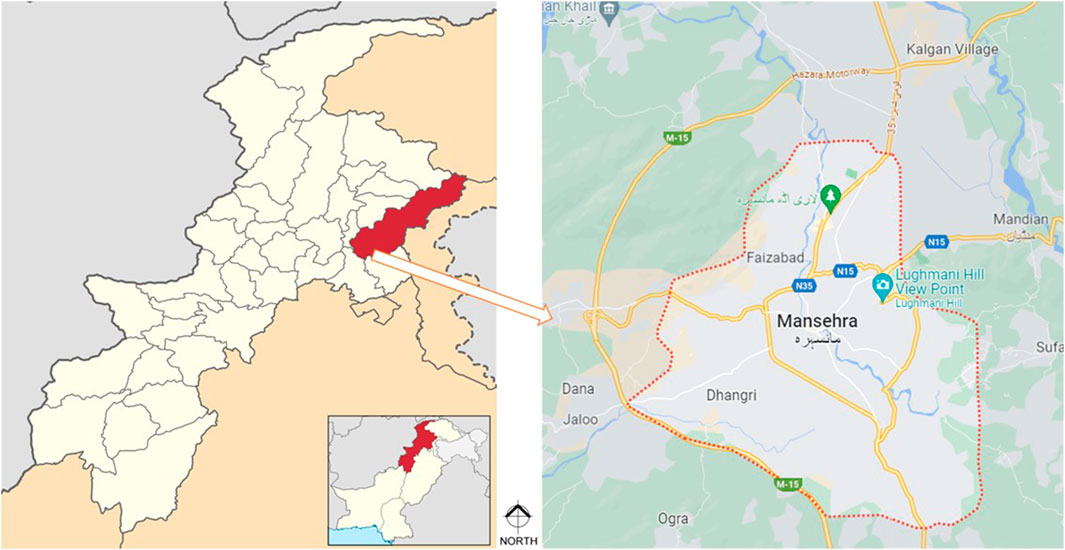
FIGURE 1. Map showing geographical location of Mansehra District in KPK and the location of Mansehra city (Source: CC BY-SA 4.0).
First, primary data, through field notes and photographs, systematic observation of selected houses were conducted on four weekdays in November 2021 (10 am–5 pm). Later, the overhangs on the east, west, and south sides were documented for exploratory research. To compare the effectiveness of south side overhangs, sun Altitude angles on the shortest and longest days of the year, 22 December and 22 July (summer and winter solstices), were calculated, and south side overhangs were placed against the summer and winter solstices to see how effective they were in winters and summers against the highest angles of the sun. Furthermore, all six house models were placed against the Sketch up extension Curic Sun to find out the complete sun angles and real-time behavior of all sides’ overhangs on the longest and shortest day of the year and to test the overhangs of all sides (east, west, and south) against these sun angles other than the solstice. Based on the research problem, the descriptive method was used by tabulating the data obtained from building plan, section, and detail measurements.
4 Framing the case study area
In the Khyber Pakhtunkhwa (KPK) province, the Mansehra district is located on the Karakoram Highway, which connects to ancient Taxila, Kashmir, Gilgit-Baltistan, China, and Central Asia. It has a total area of 4,579 square kilometers and is located at latitudes 34° 14′ and 35° 11′ north and longitudes 72° 49′ and 74° 08′ east. Its population is between 127,000 and 150,000 (Khan et al., 2020). According to Shakir and Ahmed (2014), it is bordered in the north by the districts of Batagram and Kohistan, in the east by the district of Muzafarabad in Azad Jammu and Kashmir, in the south by the districts of Abbottabad and Haripur, and the west by the district of Swat.
According to Google Maps, Abbottabad, Peshawar, and the capital Islamabad are all 28.0 kilometers, 223.7 kilometers, and 161.0 kilometers, respectively, away from Mansehra City, which lies in the Mansehra district (Khan et al., 2020). The city’s climate is pleasant, warm in the summertime, and cold in the wintertime; the winter season lasts from October to March, and the summer season lasts from April to September (Khan et al., 2020). This suggests that there are two types of weather in the city, both of which have an impact on passive building methods. The Hazara people have a long history that dates back to the Stone Age. According to (Ali, 2005), there is evidence that methodical investigation and the discovery of archaeological materials linked this area to successive eras, including Persian, Greek, Mauryan, Indo-Greeks, Scythians, Parthians, Kushans, Hindu-Shahi, Islamic, Sikh, and British periods (Khan et al., 2020). The city’s annual population growth rate is 4.62%, as reported by the 2017 census, greater than the 3.58 percent annual growth rate predicted by Ace Consulting Engineers and the NWFP Urban Development Project (NUDP). The residents of this city have access to urban infrastructure, social services, transportation, and jobs (Shakir and Ahmed, 2014). Residential, commercial, and industrial land uses make up the majority of its use. Compared to other activities, the residential area makes up a higher share. The municipal government says most structures are between 10 and 50 years old. The overall number of houses in the Mansehra district, as reported by the KPK government, is 17, 2040, while the total number of houses in the city, as reported by the Mansehra municipality, is about 11,000 (Awan et al., 2011).
5 Findings
This section presents findings from three different category houses. Two houses in each category have been investigated from their overhang details and cross-sectional analysis (see Table 1). In each category, house plans are used to explain overhang analysis while sun Altitude angles on the shortest and longest days of the year, 22 December, and 22 July (summer and winter solstices) were calculated (see Table 2).
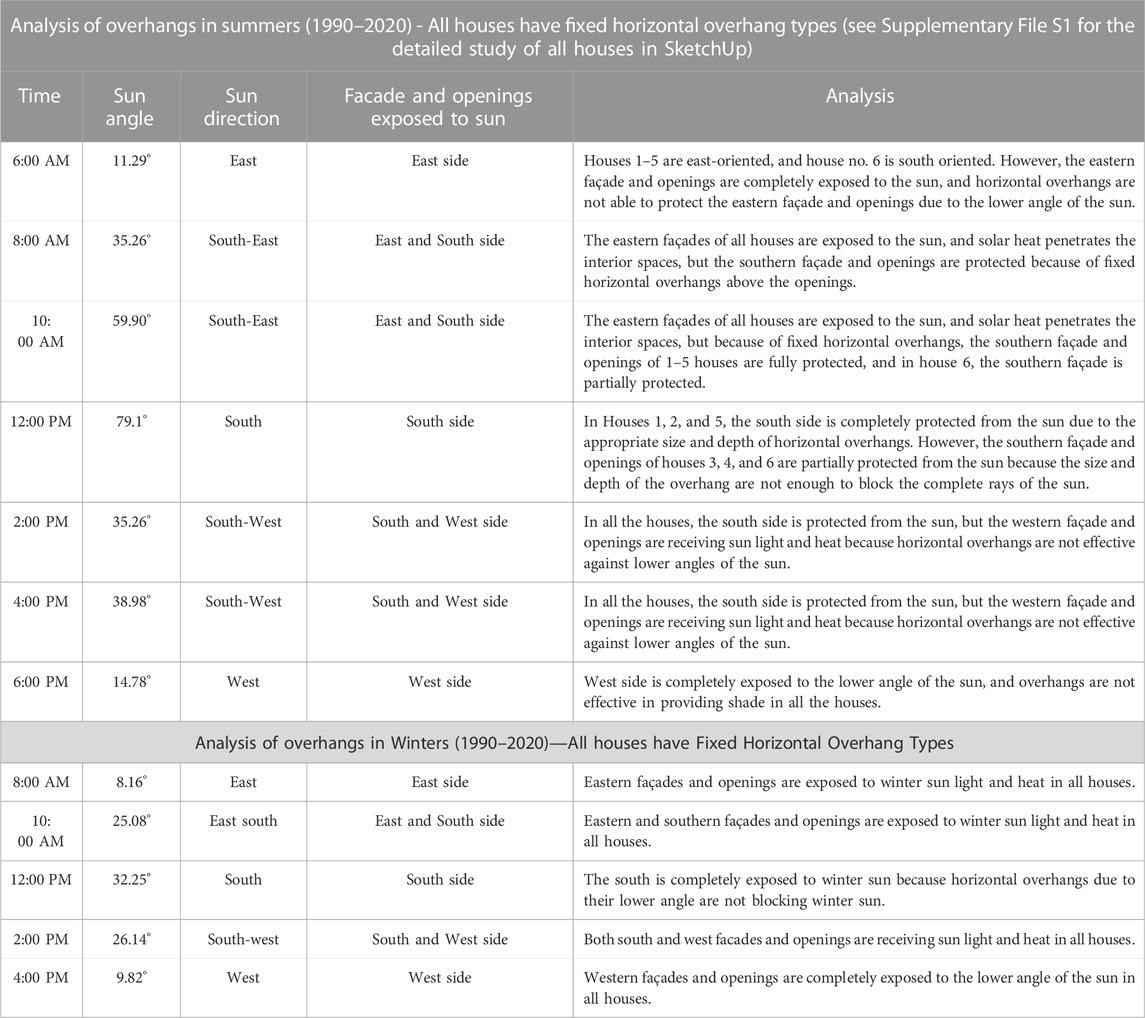
TABLE 2. Analysis of overhangs of 1990–2000, 2000–2010, and 2010–2020 category’s houses in summers and winters (Author, 2022).
5.1 Selected houses from 1990 to 2000
Two houses were selected from the 1990–2000 category. Both houses were located in Dab no 1. House no. 1 is a single-story 20 Marla house (5,444 sq ft) while house number 2 is a bit more compact and has two floors in 10 Marla (2,723 sq ft). Nine inches thick brick walls were used in the construction of both houses. Six inches R.C.C. roof and simple plain cement concrete floors were used in the construction. Semi-open and the open area were oriented on the south side making a south-oriented open courtyard. Both houses have No other open areas left on the west or north side (see Figures 3A, B).
5.1.1 Overhangs detail and analysis of 1990–2000 category houses
House 1 had east side shading, and a 2 feet long roof extension was provided over windows, as well as 1.5–2 feet wide fixed R.C.C. overhangs followed the same length as the windows. Only house 1 had windows on the west side, shaded (R.C.C) with a 2 feet long roof extension. Both houses had roof extensions on the south side, which were 7–10 feet wide and ran the entire length of the linear plan (see Table 1).
5.1.2 Sectional study of overhangs of houses of 1990–2000 category houses
During the summer (June 21), the eastern façade and windows are exposed to direct sunlight for nearly 4 h from 6 a.m. to 11 a.m., and the sun’s angle varies from 11.300 to 71.430 degrees. East-side overhangs provide no shade in this time period because the angle of the sun is quite low, and these overhangs are horizontal in nature (Table 2). Because of this direct exposure, interior spaces are exposed to direct heat and light (also associated with glare problems). Western facades and windows are also exposed to the sun’s direct lower angle from 2 p.m. to 6 p.m. When the angle of the sun decreases and varies from 63.490 to 14.77, western overhangs were also horizontal in nature; therefore, they also failed to provide relief in terms of direct heat and direct light gain. Southern facades are exposed to direct and indirect sunlight for almost 8 h, from 8 a.m. to 4 p.m., during which the sun reaches its highest level at 12 p.m. with an angle of 78.94. The sun is in the southeast from 8 a.m. to 12 p.m., and from 12 a.m. to 12 p.m., it is in the southwest. As a result, the south side of buildings receives the most sunlight during the day (Table 2). Overhangs on the southern side were 7–10 feet wide, and they covered the maximum space of the building. These overhangs were perfect for providing shading from direct sun heat and direct sunlight see Figures 4A, B.
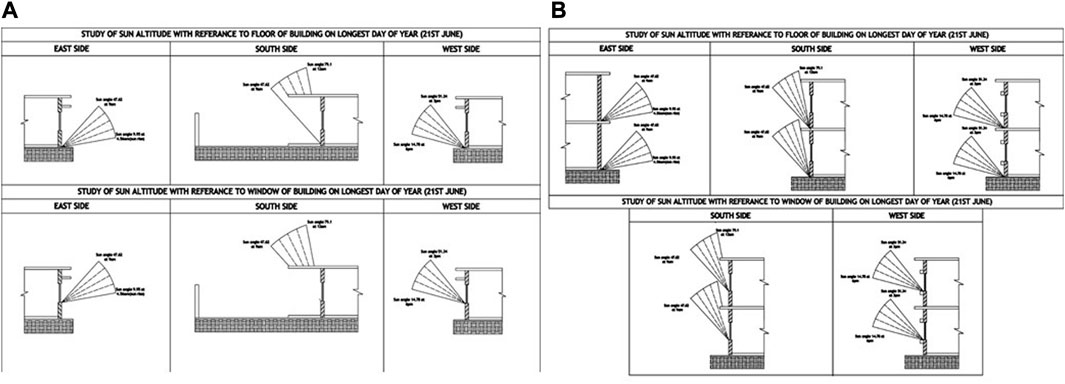
FIGURE 4. (A) Study of sun attitude House 1 on longest day of the year—21st June 2022 (Author). (B) Study of sun attitude House 2 on longest day of the year—21st June 2022 (Author).
During winters both house’s eastern and western façade receives direct sunlight, and as overhangs are horizontal in nature, they fail to diffuse the incoming light, but this is beneficial in terms of space heating. The southern façade receives maximum sunlight in winter for almost 4 h as shown in Figures 5A, B, and all the major activity spaces are placed in the south to take maximum benefit from the south sun in winter. Verandas (south side overhangs) provides heated covered spaces for a maximum period of daytime. It also creates different temperature zones between indoor and outdoor areas which create high pressure in indoor spaces and low pressure in outdoor spaces. This helps to ventilate the colder indoor air to the outside zone (Figures 5A, B).
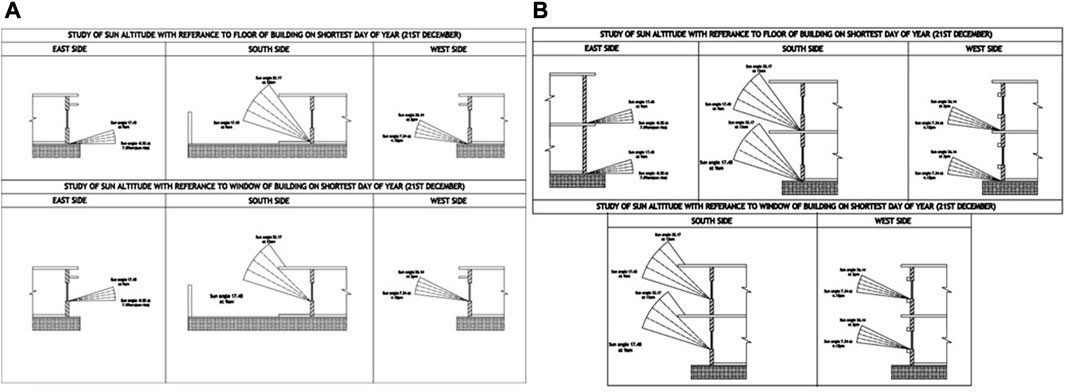
FIGURE 5. (A) Study of sun attitude House 1 on shortest day of the year—21st December 2022 (Author, 2022). (B) Study of sun attitude House 2 on shortest day of the year—21st December 2022 (Author).
5.2 Selected houses from 2000 to 2010 category
Two houses were selected from the 2000 to 2010 category. Both houses are located on Safdar Road. The area of house 3 is 17 Marla (4,628 sq ft). While the area of house 4 is 11 Marla (2,992 sq ft). Nine inches thick brick walls were used in the construction of these houses. Floors were constructed of one-inch Marble while six inches R.C.C. was used in roof construction. The percentage of open area was 30%–36% of the total area in this housing category. Open areas are present on 3 or 4 sides of the house. A proper provision of the courtyard is missing in house 4. However, minor setbacks are 1.5–2 feet from boundary walls on both sides (see Figures 6A, B).
5.2.1 Overhangs detail and analysis of 2000–2010 category houses
House 3 had south-side shading and a 2 feet long roof projection shaded windows. In addition, the north side of the house does not have any overhangs and shading devices that allow it to penetrate the sunlight in the interior spaces. Considering the windows and shading devices of house 4, it does not have any windows on the east side, but the rest of the sides have windows with the 2 feet long roof projections and follow the same length as the length of the wall. Both houses had roof extensions on the south side, which ran the entire length of the linear plan.
5.2.2 Sectional study of overhangs of 2000–2010 category houses
House 3 was shaded with a 2 feet long roof extension at the eastern side. The eastern side of house 4 also had a 7 feet roof extension but no windows. Windows on the west side were shaded by a 2 feet long roof extension and fixed shading devices made of R.C.C. that is 1.5–2 feet wide and followed the same length as the windows. There were no shading devices found on the north side. House 3 had windows on the south side, shaded by a 2–3 feet long roof extension. On the southern facades of house 4, two windows are available: one standard with a 2 feet window overhang and a 4 feet roof extension, and the other with an almost 8 feet long roof extension.
In the summer (June 21), the eastern façade and windows are exposed to direct sunlight for nearly 4 h from 6 a.m. to 11 a.m., and the sun’s angle varies from 11.30 to 71.43 degrees. East side overhangs provide no shade in this time period because the angle of the sun is quite low and these overhangs are horizontal in nature; because of this direct exposure, interior spaces are exposed to direct heat and direct light (which is also associated with glare problems, see Table 2).
Western facades and windows are also exposed to the sun’s direct lower angle from 2 p.m. to 6 p.m. when the angle of the sun decreases and varies from 63.49 to 14.77, and western overhangs were also horizontal in nature; therefore, they also failed to provide relief in terms of direct heat and direct light gain (see Figures 7A, B). In house 3, the southern façade was not continuous like in houses studied from 1990 to 2000. One of the structure sections was recessed back into the plot area in order to use it as car parking. This area also had a single-room window; the other part of the southern facade had just 2 feet of overhang on windows and 2 feet of roof extension.
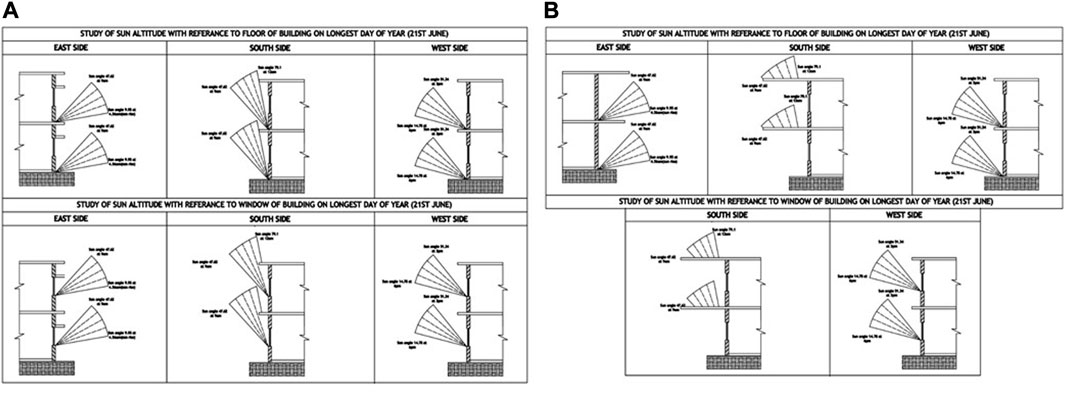
FIGURE 7. (A) Study of sun attitude House 3 on longest day of the year—21st June 2022 (Author). (B) Study of sun attitude House 4 on longest day of the year—21st June 2022 (Author).
The model study shows that the southern façade was completely exposed to nearly 8 h of sun heat and direct sunlight in the summer (see Figure 8A). The other part of the southern façade was protected from the sun in summer. However, in winter, both parts of the southern facades and windows were able to catch the direct sun, heat, and light (see Figures 8A,B). In house 4, only four spaces were oriented on the south side, and all four have windows, but the overhangs provided are horizontal in nature (see Figure 8B). There is only a 2 feet extension wire included. All those windows and the entire southern facade were exposed to the summer sun as the overhangs were not wide enough to protect the windows from the higher angle of the sun; however, they provide some shade between 2 and 5 am.
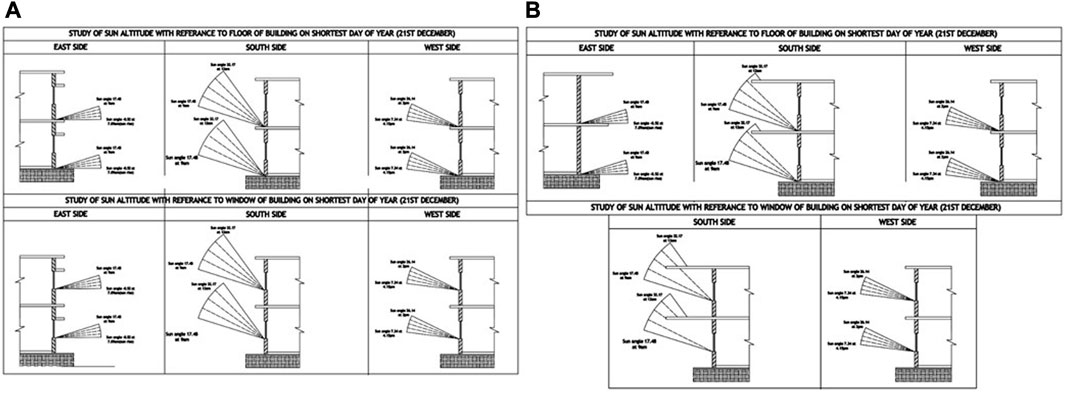
FIGURE 8. (A) Study of sun attitude house 3 on shortest day of the year—21st December 2022 (Author). (B) Study of sun attitude house 4 on shortest day of the year—21st December 2022 (Author).
5.3 Selected houses from 2010 to 2020 category
House numbers 5 and 6 were selected from Safdar Road and dab no1. The area of house 5 is 17 Marla (4,628 sq ft.) while the area of house 6 is only 7 Marla (1905 sq ft) making it the smallest house among all categories used in this study. Nine inches thick brick walls were used in the construction of house number 5 while house number 6 was built by solid blocks. One-inch Marble was used in floors and six inches R.C.C. roof was used in both house’s construction. The percentage of the open area has reduced to 27%–30% of the total area the only semi-covered area is used as parking and on the left or right side had an open area. Setbacks of 2 feet from boundary walls also introduce in the open area which separates the plot boundary from internal walls (see Figures 9A, B).
5.3.1 Overhangs detail and analysis of 2010–2020 category’s houses
A 2 feet long roof extension shaded the eastern-facing windows in House 5, and the windows also had fixed RCC overhangs that were all 1.5–2 feet wide and ran the same length as the windows. House 6 had an east-facing front with six windows, and all had R.C.C. roof extensions of different widths; all were horizontal. Windows on the west side of both houses were shaded by a 2 feet long roof extension, as well as fixed shading devices made of R.C.C. (1.5–2 feet wide) followed the same length as the windows. There were no shading devices found on the north side. House 5 had almost 10 feet of roof extension on the south side, while House 6 had no windows on the southern side (see Table 2).
Although in house 5 the east side had longer shading devices in comparison to other sides due to lower angles on the eastern side. However, these overhangs were not able to provide any relief in the summer as they were completely exposed to summer heat and light. The eastern façade and east side windows were facing south for almost 6 h. Conversely, this seems beneficial in winter as these facades face the maximum amount of winter sun, which provides needed warmth and daylight in winter (Table 2). Western facades and window overhangs remained the same as the previous ones and were exposed to declining sun heat and light for almost 4–5 h. Though, they also receive sun heat for nearly 3 h during the winter.
On the south side, house 5 had no windows, while house 6 had two south-facing spaces as well as a nearly 10 feet long roof extension that served as a horizontal shading device. Because of this roof extension, the southern façade and windows were completely protected from the sun in the summer, and in the winter, both the façade and windows were able to collect solar heat and light from 9 a.m. to 3 p.m. More details on summer and winter (see category 1).
5.3.2 Sectional study of overhangs of 2010–2020 category houses
House 5 was shaded with a 2 feet long roof extension at the western side. The western side of the other house (house 6) also had a roof extension running the wall length and shaded windows and ventilators. Windows on the north side of house 5 were shaded by the balcony projected 6 feet from the wall. No shading devices were found on the ventilators of the southern side of this house. The northern side of house 6 has a small ventilator covered with the roof projection. Similarly, this house had no windows on the south side, but the façade has 2 feet deep roof projection running throughout the wall length. On the eastern facades of house 6, there were three windows: one window shaded with the 2 feet deep roof projection while the remaining two were shaded with the projected balcony and eastern side of house 5 has two ventilators and one window with the two feet deep overhang and has roof projection running throughout the wall length.
In the summer (June 21), the eastern façade and windows are exposed to direct sunlight for nearly 4 h from 6 a.m. to 11 a.m., and the sun’s angle varies from 11.30 to 71.43 degrees. East side overhangs provide no shade in this time period because the angle of the sun is quite low and these overhangs are horizontal in nature; because of this direct exposure, interior spaces are exposed to direct heat and direct light (Table 2).
Western facades and windows are also exposed to the sun’s direct lower angle from 2 p.m. to 6 p.m. when the angle of the sun decreases and varies from 63.49 to 14.77, and western overhangs were also horizontal in nature; therefore, they also failed to provide relief in terms of direct heat and direct light gain (see Figures 10A, B). In house 5, the southern façade was not continuous like in houses studied from 1990 to 2000. One of its building sections was recessed back, and the space was used as a veranda (roof overhang) that also acted as a buffer space between the interior and exterior and prevented the sun penetration into the interior spaces. On the other hand, house 6 has no openings on the southern façade preventing the interior spaces from radiation from the hot sun (see Figures 11A, B).
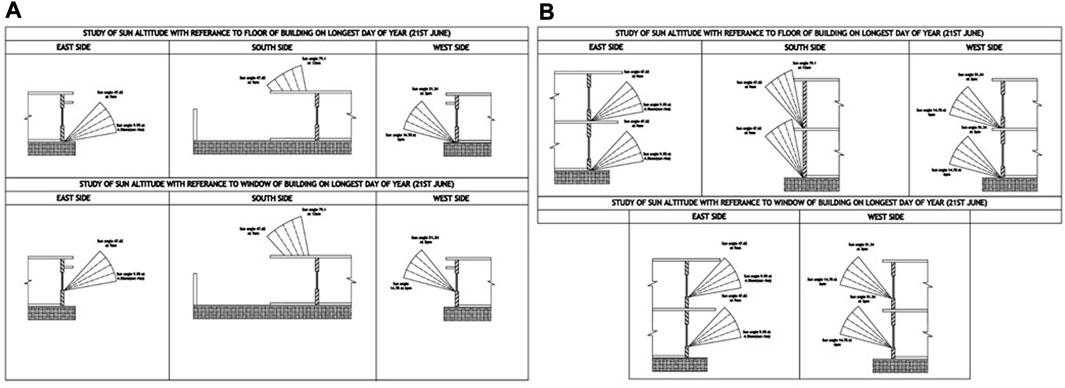
FIGURE 10. (A) Study of sun attitude house 5 on longest day of the year—21st June 2022 (Author). (B) Study of sun attitude house 6 on longest day of the year—21st June 2022 (Author).
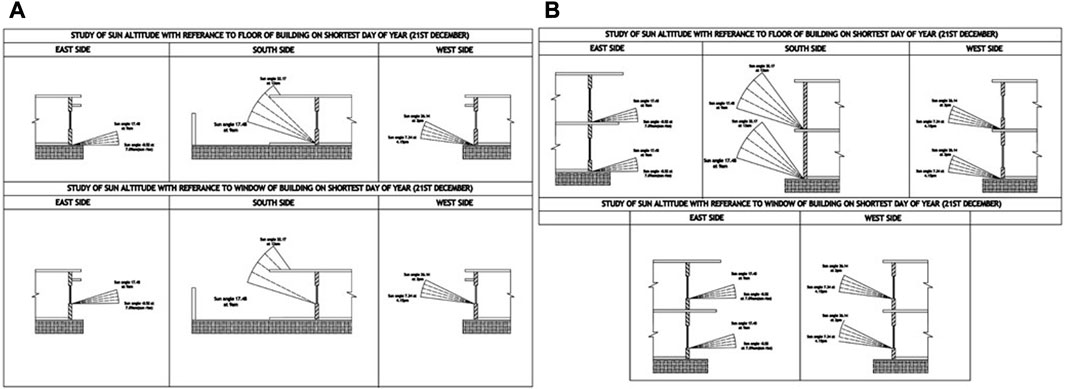
FIGURE 11. (A) Study of sun attitude house 5 on shortest day of the year—21st December 2022 (Author). (B) tudy of sun attitude house 6 on shortest day of the year—21st December 2022 (Author).
6 Discussion
In order to provide adequate daylight levels, reduce glare, and at the same time offer a view connected to the exterior, this study evaluates the design possibilities of external shading devices with various depths and elevations for the case of houses in Mansehra City, KPK, Pakistan (see Table 3). The findings from this study demonstrates that the utilization of shading devices and overhangs in the structures is crucial to control the solar gains and the solar radiation penetration in the interior spaces (Table 3). This control is mandatory because it will reduce the energy use. As indicated by Yu and Su (2015), due to solar gains, solar radiation entering buildings can have a negative impact by increasing the need for cooling energy during the hot months; therefore, control is necessary. In this study, further supported by Rashid et al. (2019), the significance of shading devices and overhangs in reducing the heat gains within the structure is one of its main components, in addition to the fenestration design and large windows (Rashid et al., 2019).
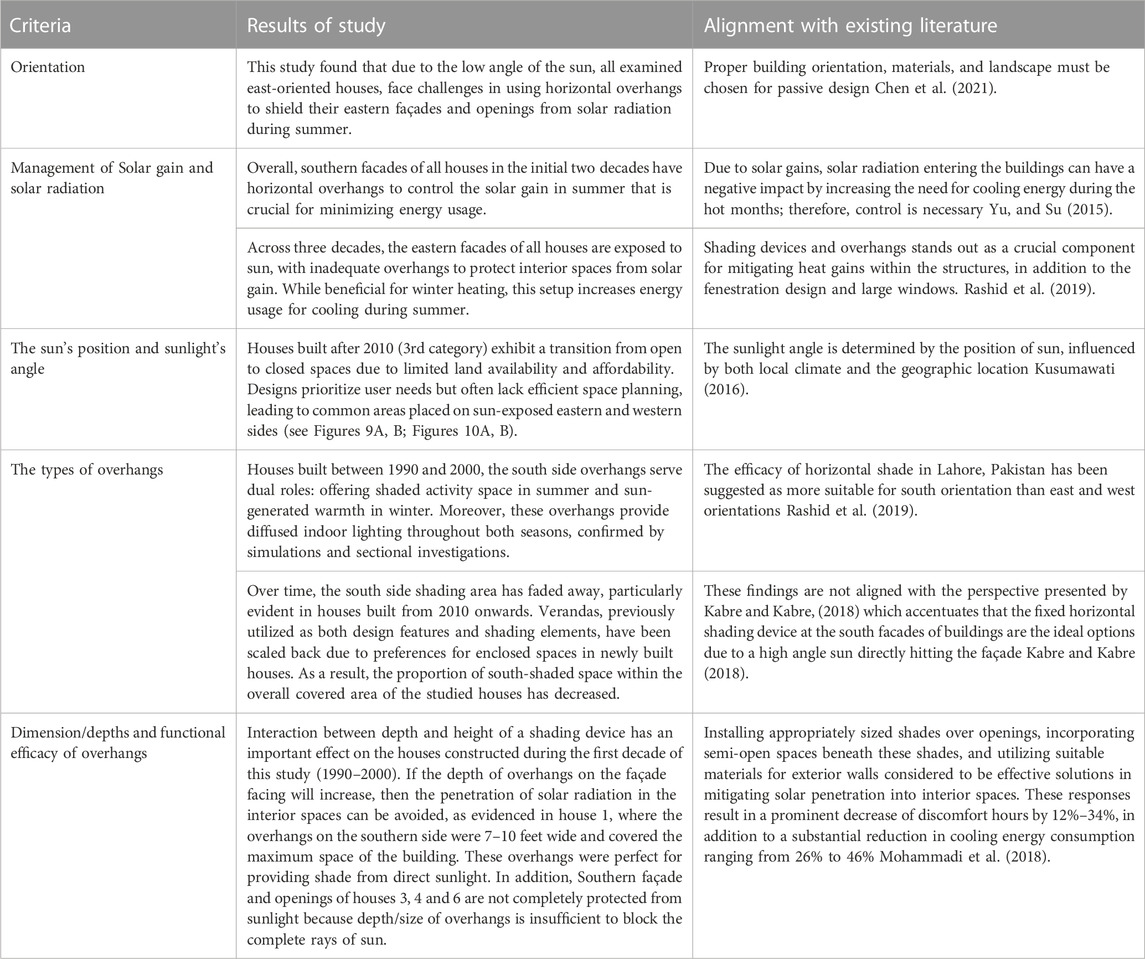
TABLE 3. Study outcomes concerning the preferred case study selection criteria and their alignment with existing literature (Author, 2022).
In addition, depending on the use of space, orientation of the building structure and the presence of direct sunlight, the interaction between depth and height of a shading device has an important effect on the houses constructed between the first decades of this study (1990–2000). However, in order to achieve better results a number of challenges must be dealt with in future design. For instance, the orientation and zoning of spaces must be considered in the design of the houses, and it is also suggested by Chen et al. (2021) that the proper building orientation, materials, and landscape must be chosen for passive design. In contrast, in the case studies of three decades, all the houses are east-oriented, and horizontal overhangs failed to protect the interior spaces from the solar radiation in summer because the angle of the sun is quite low. However, there is a close relationship between the dimension/depth of overhangs and solar gain. If the depth of overhangs on the façade facing will increase, then the penetration of solar radiation in the interior spaces can be avoided, as evidenced in house 1, where the overhangs on the southern side were 7–10 feet wide and covered the maximum space of the building. These overhangs were perfect for providing shade from direct sunlight. In contrast, the Southern façade and openings of houses 3, 4 and 6 are not completely protected from sunlight because depth/size of overhangs is not enough to block the rays of sun. These results align with the findings of Mohammadi et al. (2018), which showed that the solutions to prevent solar penetration into interior spaces through erecting shades of suitable sizes over the openings, placing semi-open spaces under shades, and using suitable materials in exterior walls were an appropriate response to the regional climate behaviors and led to a reduction in discomfort hours of between 12 and 34 percent and a reduction in cooling energy consumption of between 26 and 46 percent. However, itis also very important to consider the unavailability of land for the spaces therefore the size and design of shading devices should be considered consciously for all orientations.
From 1990 to 2000 category houses, most functional and commonly used spaces (such as kitchen) were oriented on the south side with verandas (south side roof overhangs), followed by fully open yards (see Figures 3A, B). This placement created a consecutive sequence of open, semi-open, and closed spaces. This variation in space created different pressure zones, forcing cool air to circulate in the summer and extracting cool air from indoor spaces into the open yards in the winter. The south side overhangs serve as an activity area for users in the summer because they provide shade in the summer and sun heat in the winter; additionally, these south side overhangs provide diffused light to indoor spaces in both winter and summer, as evidenced by simulations and sectional studies (see Figures 4A, 5B). These results align with a previous study by Rashid et al. (2019) in Lahore, Pakistan where the efficacy of horizontal shade has been suggested as more suitable for south orientation than east and west orientations (p. 7). Similarly, houses constructed in the year 2000 or later (second category) have a Southside overhang; however, planning in those houses is completely different compared to the houses built in the previous decade (See Figures 6A, B). Additionally, houses built between 1990 and 2000 have limited space usage. For instance, the drawing room, guest room, kitchen, and stores were placed on the east and west sides, which were exposed to both heat and light in summer but also received sun and light in winter. Only two rooms were getting benefits from these overhangs: drawing rooms and sleeping rooms. As these overhangs were not a feasible option, these spaces were subjected to direct light instead of diffused light, which caused glare and inconvenience. However, the design of the houses constructed in 2010 or later (3rd category) shifted from open to closed spaces because of minimum or no land availability and affordability (see drawings of houses number 5 and 6 in Figures 9A, B). In addition, the focus seems to fulfill the requirements of users that lack efficient space planning and result in the placement of commonly used spaces on the eastern and western sides that are directly exposed to the sun and heat (see Figures 10A, B). These results align with the results highlighted by Kusumawati (2016); the sun’s position determines the sunlight’s angle which depends on the local climate and the sun’s location.
Unfortunately, the area for shading devices on the south side has reduced over time, and the use of verandas (south side roof overhangs) as design elements and as shading devices has also been minimized because people prefer to cover the open spaces for other purposes such as rooms and other enclosed spaces in the houses constructed in the year 2010 or later. The percentage of south-shaded space has decreased in the overall covered areas of the studied houses. However, this practice is not favorable for the residents as indicated by Kabre and Kabre (2018) that the south facades of buildings, where the sun is at a high angle are the ideal options for the fixed horizontal shading device. On the other hand, east and west side shading devices remained almost the same because most of the space’s arrangement has been changed in the north and south orientation that was left open in the early decades due to many reasons such as copying modern planning from the west. Their sizes and designs remained almost the same during the studied period of time; in houses constructed in 2010 or later, however, separate window shades (window overhangs) disappeared. Between 1990 and 2000, the south sides of houses were well protected from the summer sun and received adequate sunlight during the winter. Shading devices on the east and west sides were not functional and effective (against the sun’s low angle) during the morning and afternoon. Since 2000, the south side of most houses has been completely exposed to summer sun, which causes indoor temperatures to rise, but they are somehow beneficial in the winter because they receive winter sun.
Overall, the eastern facades of all houses of three decades are exposed to the direct sunlight and overhangs are not sufficient enough to protect the interior spaces from the sun gain. This situation is ideal in winter when sun heat is required to heat up the internal spaces however, it increases the use of energy for cooling the interior in the summer. These results align with the study of Rashid et al. (2019) that emphasized the significance of shading devices and overhangs in reducing the heat gains within the structure and considered it as one of its main components, in addition to the fenestration design and large windows. (Rashid et al., 2019). Overall, southern facades of all houses of first two decades have horizontal overhangs to control the solar gain in summer that is very necessary to minimize the use of energy. These results aligned with the findings of Yu and Su (2015) as solar gains ingress solar radiation into the buildings can have a negative impact by increasing the need for cooling energy during the warmer months; therefore, effective control measures become imperative (Yu and Su, 2015).
7 Conclusion and recommendations
External shading devices and overhangs are more than just an aesthetic design feature of any façade; if properly designed, they also play an essential role in sustainable development by controlling heat and direct sunlight in the summer and allowing sunlight and warmth in the winter or other words by contributing to energy efficiency and reducing the environmental impact of buildings. This study concludes that southern shading devices, a prominent design element in traditional houses between 1990–2000 have become obsolete in contemporary house designs in Mansehra, KPK Pakistan. In addition, shading devices located at houses’ East and West sides remained the same with little changes in their design but were not found effective in their performance. Apart from these results, this study is limited to understanding the shading device’s effects on solar radiation, daylighting, and ventilation. Besides that, some limitations are associated with the Curic Sun tool used in this paper. Curic Sun has limited accuracy, scope, and functionality. Furthermore, Curic sun provides approximations rather than precise calculations. As a result, the results should be considered an approximation rather than an exact representation of the actual conditions. Despite the limitation, this study is a step to fulfill the knowledge gap from a medium size city Mansehra, KPK, Pakistan, and also provides an understanding of the performance and effectiveness of shading devices in terms of heat gain and daylight level in residential buildings. This study is expected to encourage more research into how a shading device affects both solar radiation and indoor thermal comfort. The combined effects are important to maximize the effectiveness of a shading device, which can lessen the penetration of solar radiation, improve indoor thermal comfort and mitigate climate change.
Based on the case study houses, the following guidelines are suggested for the future overhang design of houses in Mansehra, KPK, Pakistan: On the south side, two feet of horizontal shading devices (overhangs) are sufficient to protect the window from the sun. However, if this length is increased, windows and facades will be protected from the summer’s southeast, south, and southwest sun while being exposed to sun heat and diffused light in the winter. Western and eastern window projections (overhangs) need to be changed, as they failed to protect facades and windows from lower sun angles. Vertical and horizontal fins, louvers, and shutters are the best options to limit the heat and control the light on the west and south sides. Plantations (deciduous plants) are very beneficial for east and west shading as they shed their leaves in winter and grow them back in summer. In addition, building design should incorporate both passive and active thermal comfort strategies, allowing solar heat and diffused light in the winter and blocking heat and light in the summer. Local passive practices, such as open courtyards with plants, verandas, and open terraces on the south side, should be revitalized with a modern twist. This will help reduce energy demands while also keeping the temperature rising. It will also revitalize the traditional aspects of sustainability, and a sense of history, culture, and place, all of which are becoming obsolete in contemporary residential buildings.
However, this study has its own limitations, as most of the aspects are examined qualitatively, and the reliance of functional building plans. This study refrains from utilizing simulation tools to determine the thermal comfort performance of residential buildings. Thus, further research integrating quantitative assessments is required to produce more precise scientific data for residential buildings that engineers, and architects may use for sustainable building design in the region.
Data availability statement
The original contributions presented in the study are included in the article/Supplementary Material, further inquiries can be directed to the corresponding author.
Author contributions
AI, HN, and MAA, Conceptualization; MAA Data curation; AI, HN, and MAA, Formal analysis; HN and MAA, Methodology; AI, HN, and MAA, Project administration; MAA, Software; AI, HN, and MAA; Supervision; MAA, Visualization; HN, MAA, Writing–original draft; AI, HN, and MAA, Writing, review and editing. All authors contributed to the article and approved the submitted version.
Funding
The authors declare that no financial support was received for the research, authorship, and/or publication of this article.
Acknowledgments
Part of this paper was undertaken under the supervision of Nazia Iftakhar while one of the authors was a master’s student at Allama Iqbal open university Islamabad campus, Pakistan. The authors would like to express their thanks to the house owners who allowed us to use their houses as a case study in this research.
Conflict of interest
The authors declare that the research was conducted in the absence of any commercial or financial relationships that could be construed as a potential conflict of interest.
Publisher’s note
All claims expressed in this article are solely those of the authors and do not necessarily represent those of their affiliated organizations, or those of the publisher, the editors and the reviewers. Any product that may be evaluated in this article, or claim that may be made by its manufacturer, is not guaranteed or endorsed by the publisher.
Supplementary material
The Supplementary Material for this article can be found online at: https://www.frontiersin.org/articles/10.3389/fenef.2023.1244106/full#supplementary-material
References
Alajmi, A. F., Aba-alkhail, F., and Anzi, A. A. L. (2021). Determining the optimum fixed solar-shading device for minimizing the energy consumption of a side-lit office building in a hot climate. J. Eng. Res. (Kuwait) 9 (2), 320–335. doi:10.36909/jer.v9i2.10773
Aldabesh, A., Soufi, J., Omer, S., and Haredy, A. (2021). Unlocking the residential retrofitting potential in a three-degree world: A holistic approach to passive design in hot climates. Buildings 11 (6), 228. doi:10.3390/buildings11060228
Alhuwayil, W. K., Abdul Mujeebu, M., and Algarny, A. M. M. (2019). Impact of external shading strategy on energy performance of multi-story hotel building in hot-humid climate. Energy 169, 1166–1174. doi:10.1016/j.energy.2018.12.069
Ali, I. (2005). Mapping and documentation of the cultural assets of kaghan valley, Mansehra. Islamabad: United Nations Educational, Scientific and Cultural Organization, 5–6.
Awan, M. A. (2022). “Transformation in thermal comfort elements of Houses in Mansehra city,” (Pakistan: Allama Iqbal open university Islamabad campus). (1990 -2019) (master's thesis).
Awan, M. R., Iqbal, Z., Shah, S. M., Jamal, Z., Jan, G., Afzal, M., et al. (2011). Studies on traditional knowledge of economically important plants of Kaghan Valley, Mansehra District, Pakistan. J. Med. Plants Res. 5 (16), 3958–3967.
Calama-González, C. M., Suárez, R., León-Rodríguez, Á. L., and Ferrari, S. (2019). Assessment of indoor environmental quality for retrofitting classrooms with an egg-crate shading device in a hot climate. Sustainability 11 (4), 1078. doi:10.3390/su11041078
Chen, Y., Mae, M., Taniguchi, K., Kojima, T., Mori, H., Trihamdani, A. R., et al. (2021). Performance of passive design strategies in hot and humid regions. Case study: tangerang, Indonesia. J. Asian Archit. Build. Eng. 20 (4), 458–476. doi:10.1080/13467581.2020.1798775
Dabaj, B., Rahbar, M., and Fakhr, B. V. (2022). Impact of different shading devices on daylight performance and visual comfort of A four opening sides' reading room in rasht. J. Daylighting 9 (1), 97–116. doi:10.15627/jd.2022.7
De Luca, F., Sepúlveda, A., and Varjas, T. (2022). Multi-performance optimization of static shading devices for glare, daylight, view and energy consideration. Build. Environ. 217, 109110. doi:10.1016/j.buildenv.2022.109110
Dehwah, A. H., and Krarti, M. (2021). Energy performance of integrated adaptive envelope systems for residential buildings. Energy 233, 121165. doi:10.1016/j.energy.2021.121165
Gratia, E., and De Herde, A. (2007). The most efficient position of shading devices in a double-skin facade. Energy Build. 39 (3), 364–373. doi:10.1016/j.enbuild.2006.09.001
Hashemi, A., and Khatami, N. (2017). Effects of solar shading on thermal comfort in low-income tropical housing. Energy Procedia 111, 235–244. doi:10.1016/j.egypro.2017.03.025
Heidari, A., Taghipour, M., and Yarmahmoodi, Z. (2021). The effect of fixed external shading devices on daylighting and thermal comfort in residential building. J. Daylighting 8 (2), 165–180. doi:10.15627/jd.2021.15
Hien, W. N., and Istiadji, A. D. (2003). “Effects of external shading devices on daylighting and natural ventilation,” in Proceedings of the 8th International IBPSA Conference, Eindhoven, Netherlands, August 11–14, 2003, 475–482.
Iba, C., and Hokoi, S. (2022). Traditional town houses in kyoto, Japan: present and future. Energies 15 (5), 1913. doi:10.3390/en15051913
Kabre, C., and Kabre, C. (2018). Design case studies. Sustain. Build. Des. Appl. Using Clim. Data India 2018, 103–168.
Khan, U., Khan, F., and Malik, M. F. (2020). An exploratory study of the factors that promote and delay sustainable eco-tourism development in Mansehra. Glob. Reg. Rev. V, 471–478. doi:10.31703/grr.2020(v-i).50
Kirimtat, A., Koyunbaba, B. K., Chatzikonstantinou, I., and Sariyildiz, S. (2016). Review of simulation modeling for shading devices in buildings. Renew. Sustain. Energy Rev. 53, 23–49. doi:10.1016/j.rser.2015.08.020
Koç, S. G., and Maçka Kalfa, S. (2021). The effects of shading devices on office building energy performance in Mediterranean climate regions. J. Build. Eng. 44, 102653. doi:10.1016/j.jobe.2021.102653
Kusumawati, M. L. (2016). “Shading device design based on Sun potition and indoor lighting requirements,” in International Seminar Livable Space Applying Local Knowledge for Livable Space, 193–198Available at: http://www.trisakti.ac.id/.
Lechner, N. (2014). Heating, cooling, lighting: Sustainable design methods for architects. New Jersey, United States: John Wiley & Sons.
Lucchi, E., and Buda, A. (2022). Urban green rating systems: insights for balancing sustainable principles and heritage conservation for neighbourhood and cities renovation planning. Renew. Sustain. Energy Rev. 161, 112324. doi:10.1016/j.rser.2022.112324
Mohammadi, A., Saghafi, M. R., Tahbaz, M., and Nasrollahi, F. (2018). The study of climate-responsive solutions in traditional dwellings of Bushehr City in Southern Iran. J. Build. Eng. 16, 169–183. doi:10.1016/j.jobe.2017.12.014
Mohammed, A., Tariq, M. A. U. R., Ng, A. W. M., Zaheer, Z., Sadeq, S., Mohammed, M., et al. (2022). Reducing the cooling loads of buildings using shading devices: A case study in Darwin. Sustainability 14 (7), 3775. doi:10.3390/su14073775
Pushkar, S., and Yezioro, A. (2022). External shading devices: should the energy standard Be supplemented with a production stage? Sustainability 14 (19), 12690. doi:10.3390/su141912690
Rashid, M., Malik, A., Gulzar, S., and Jalil, A. (2019). The efficacy of shading design in commercial buildings in the semi-arid climate of Lahore; focusing on the geometry of horizontal shade. Tech. J. 24 (02).
Raza, M. Y., and Lin, B. (2022). Analysis of Pakistan's electricity generation and CO2 emissions: based on decomposition and decoupling approach. J. Clean. Prod. 359, 132074. doi:10.1016/j.jclepro.2022.132074
Schnieders, J., Feist, W., and Rongen, L. (2015). Passive Houses for different climate zones. Energy Build. 105, 71–87. doi:10.1016/j.enbuild.2015.07.032
Shakir, M. M., and Ahmed, S. (2014). Economic functioning of secondary cities of Pakistan and its integration with the physical land use: case of larkana and Mansehra. J. Archit. Plan. Res. 16, 33–54.
Sun, N., Cui, Y., and Jiang, Y. (2018). Lighting and ventilation-based building sun-shading design and simulation case in cold regions. Energy Procedia 152, 462–469.
Xu, Y., Bo, R., Chang, W. S., Guo, H., and Shao, Y. (2022). The use of horizontal shading devices to alleviate overheating in residential buildings in the severe cold region and cold region of China. Buildings 12 (4), 408. doi:10.3390/buildings12040408
Yu, X., and Su, Y. (2015). Daylight availability assessment and its potential energy saving estimation–A literature review. Renew. Sustain. Energy Rev. 52, 494–503. doi:10.1016/j.rser.2015.07.142
Keywords: climate change, shading devices, passive strategies, energy efficiency, Mansehra City
Citation: Iqbal A, Nazir H and Awan MA (2023) Design of external shading devices in Mansehra, Pakistan and their role in climate change. Front. Energy Effic. 1:1244106. doi: 10.3389/fenef.2023.1244106
Received: 11 July 2023; Accepted: 05 September 2023;
Published: 18 September 2023.
Edited by:
Mohd Faris Khamidi, Qatar University, QatarReviewed by:
Hasim Altan, Prince Mohammad bin Fahd University, Saudi ArabiaElena Lucchi, Polytechnic University of Milan, Italy
Copyright © 2023 Iqbal, Nazir and Awan. This is an open-access article distributed under the terms of the Creative Commons Attribution License (CC BY). The use, distribution or reproduction in other forums is permitted, provided the original author(s) and the copyright owner(s) are credited and that the original publication in this journal is cited, in accordance with accepted academic practice. No use, distribution or reproduction is permitted which does not comply with these terms.
*Correspondence: Asifa Iqbal, asifa.iqbal@hig.se
 Asifa Iqbal
Asifa Iqbal Humaira Nazir
Humaira Nazir Muhammad Ashar Awan
Muhammad Ashar Awan